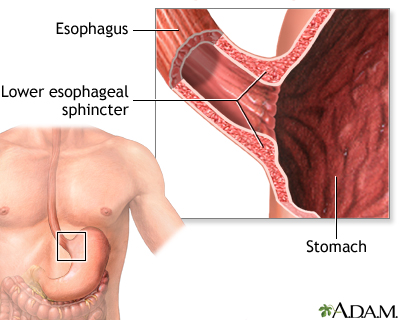Achalasia
Normal anatomy
|
|
The esophagus carries food from the mouth to the stomach. The lower esophageal sphincter is a muscular ring at the junction of the esophagus and the stomach. The lower esophageal sphincter relaxes when food from the esophagus enters the stomach.
|
Indications
|
|
Achalasia is a disorder in which the esophageal sphincter does not relax when food passes down the esophagus to the stomach. As a result, the esophagus becomes distended and filled with food, and food passes into the stomach very slowly.
Achalasia is often associated with chest pain during eating, weight loss, and regurgitation of food. The esophagus becomes distended as food and liquid are unable to pass into the stomach.
|
Procedure, part 1
|
|
Achalasia can sometimes be treated with medication that helps the lower esophageal sphincter relax. If medication is ineffective, however, esophageal dilatation can correct the problem.
To open the esophagus, a balloon dilator is passed through the mouth down to the level of the lower esophageal sphincter, using an endoscope. The balloon is inflated, thus stretching the sphincter.
|
Incision
|
|
If achalasia recurs after balloon dilatation, surgery may be necessary to correct the defect. This surgery can often be done laparoscopically.
Laparoscopic surgery involves a number of small incisions made in the upper abdomen, into which the surgeon inserts a long, thin camera and surgical instruments.
|
Procedure, part 2
|
|
The surgeon then makes a long incision in the esophagus at the level of the esophageal sphincter. This releases the sphincter and allows it to relax. This surgery is very effective in curing achalasia, with over 90% of patients obtaining relief from symptoms post-operatively.
Recovery is generally rapid, and most patients are able to leave the hospital within 1 to 3 days. Infrequently, the operation cannot be accomplished laparoscopically, and a larger incision is required. In these cases, hospitalization times may be longer.
|

Review Date:10/25/2021
Reviewed By:Michael M. Phillips, MD, Emeritus Professor of Medicine, The George Washington University School of Medicine, Washington, DC. Also reviewed by David Zieve, MD, MHA, Medical Director, Brenda Conaway, Editorial Director, and the A.D.A.M. Editorial team.
The information provided herein should not be used during any medical emergency
or for the diagnosis or treatment of any medical condition. A licensed medical professional
should be consulted for diagnosis and treatment of any and all medical conditions. Call 911
for all medical emergencies. Links to other sites are provided for information only -- they
do not constitute endorsements of those other sites. © 1997-A.D.A.M., Inc. Any duplication or distribution of the information contained herein is strictly prohibited.
The Agency for Health Care Administration (Agency) and this website do not claim the information on, or referred to by, this site is error free. This site may include links to websites of other government agencies or private groups. Our Agency and this website do not control such sites and are not responsible for their content. Reference to or links to any other group, product, service, or information does not mean our Agency or this website approves of that group, product, service, or information.
Additionally, while health information provided through this website may be a valuable resource for the public, it is not designed to offer medical advice. Talk with your doctor about medical care questions you may have.





